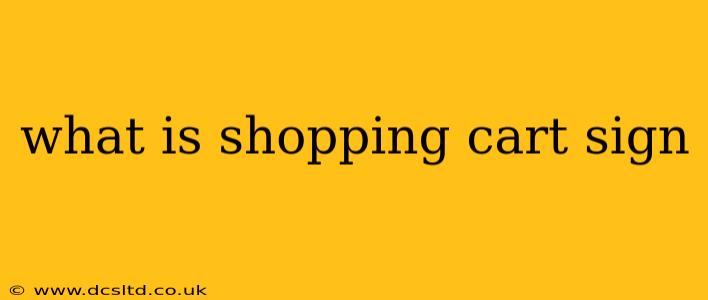What is a Shopping Cart Sign? Understanding the Symbol of Online Commerce
The shopping cart sign, that ubiquitous icon found on nearly every e-commerce website, is a visual representation of a customer's online shopping basket or cart. It's a crucial element of user interface (UI) design, instantly recognizable to online shoppers worldwide. But what exactly does it signify, and why is it so important?
This seemingly simple symbol plays a vital role in guiding customers through the online purchasing process. It serves as a clear visual cue, indicating where users can view the items they've selected for purchase, manage their order, and proceed to checkout. Its familiarity and widespread adoption contribute significantly to a seamless and intuitive online shopping experience. Think of it as the digital equivalent of a physical shopping cart in a brick-and-mortar store.
How Does the Shopping Cart Icon Function?
The shopping cart icon typically appears prominently on a website's navigation bar or header. Clicking on it usually opens a window or page displaying the contents of the user's cart. This display often includes:
- List of Items: A detailed list of the products added to the cart, including names, quantities, and prices.
- Total Price: The overall cost of the items, including taxes and shipping (if applicable).
- Options: Buttons or links allowing users to update quantities, remove items, proceed to checkout, or return to shopping.
Beyond the Basics: Variations and Interpretations
While the basic design remains consistent—a stylized image of a shopping cart—there can be subtle variations. Some sites might incorporate animations or subtle visual cues to indicate items added to the cart. Others may use a slightly different design to better match their overall branding. Despite these variations, the core meaning remains universally understood.
The Importance of the Shopping Cart Sign in E-commerce
The effectiveness of the shopping cart sign lies in its simplicity and intuitive nature. It’s a powerful symbol that immediately communicates the following:
- Clarity: It clearly indicates where users can access their selected items.
- Ease of Use: It streamlines the shopping process, making it easy for users to manage their purchases.
- Confidence: Its consistent presence reassures users that their selections are saved and readily available.
- Conversion Rate: A well-designed and strategically placed shopping cart icon contributes to a higher conversion rate.
Frequently Asked Questions about Shopping Cart Signs
Here are some common questions about shopping cart signs, and their answers:
1. Why is the shopping cart icon so universally recognized?
The icon's widespread recognition is due to its consistent use across various e-commerce platforms. Its simple and intuitive design makes it easily understood, regardless of language or cultural background. Years of consistent use have cemented its position as a universally understood symbol.
2. Are there any alternative icons used for shopping carts?
While the shopping cart icon is the most prevalent, some websites may use slight variations or even entirely different icons, such as a bag or a box. However, the core function remains the same: to represent the user's collection of items intended for purchase.
3. What happens if I close my browser window without checking out?
Most reputable e-commerce sites maintain the contents of your shopping cart using cookies or session data. This means your items will typically remain in your cart until you either check out or clear your cart manually. However, it's always best to complete the checkout process promptly to avoid any potential issues.
4. Can I customize the look of my shopping cart icon?
Yes, many e-commerce platforms allow for some customization of the shopping cart icon, letting you match its style and appearance to your website's overall design language.
In conclusion, the shopping cart sign, despite its apparent simplicity, is a crucial component of successful e-commerce. Its clear visual communication and ubiquitous recognition contribute to a more streamlined, user-friendly, and ultimately more profitable online shopping experience.
